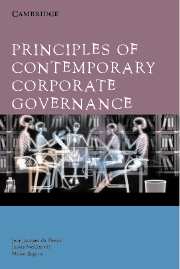Book contents
- Frontmatter
- Contents
- Table of cases
- Table of statutes
- Preface
- PART ONE CORPORATE GOVERNANCE: AN OVERVIEW
- PART TWO CORPORATE GOVERNANCE IN AUSTRALIA
- PART THREE CORPORATE GOVERNANCE IN PRACTICE
- 9 Implementation of the ASX Best Practice Recommendations: charters, policies and codes
- 10 Auditors and audits
- 11 Directors' duties and liability
- PART FOUR CORPORATE GOVERNANCE: AN INTERNATIONAL PERSPECTIVE
- PART FIVE CORPORATE GOVERNANCE: GOING FORWARD
- Index
9 - Implementation of the ASX Best Practice Recommendations: charters, policies and codes
- Frontmatter
- Contents
- Table of cases
- Table of statutes
- Preface
- PART ONE CORPORATE GOVERNANCE: AN OVERVIEW
- PART TWO CORPORATE GOVERNANCE IN AUSTRALIA
- PART THREE CORPORATE GOVERNANCE IN PRACTICE
- 9 Implementation of the ASX Best Practice Recommendations: charters, policies and codes
- 10 Auditors and audits
- 11 Directors' duties and liability
- PART FOUR CORPORATE GOVERNANCE: AN INTERNATIONAL PERSPECTIVE
- PART FIVE CORPORATE GOVERNANCE: GOING FORWARD
- Index
Summary
The effect of the ASX principles has been pervasive – in so many sectors: financial institutions, universities, arts companies, professional associations, funding bodies or regulators have been using the principles (or a modified version of them) as a set of benchmarks.
Alan Cameron, ‘Corporate Governance is Here to Stay’, CCH Update, 10 January 2005.Implementing the ASX Principles of Good Corporate Governance and Best Practice Recommendations
As was discussed in Chapter 7, the ASX Principles of Good Corporate Governance and Best Practice Recommendations (‘Best Practice Recommendations’) are now in operation, meaning ASX-listed companies (‘listed companies’) are required to comply with each of the 28 Recommendations, or explain why not in their annual report (as required by ASX Listing Rule 4.10.3). These Recommendations represent implementation guidance for listed companies to satisfy the 10 Principles of Good Corporate Governance established by the ASX Corporate Governance Council (also mentioned in Chapter 7).
In Chapter 7, we explained that a number of the Best Practice Recommendations submit that, as a matter of best practice, the listed company should adopt (and disclose to shareholders) a particular charter or policy. The Recommendations also state that best practice requires listed companies to establish a clearly marked corporate governance section on their website, and to make available in this area the company's charters and policies (also depicted in Chapter 3, Figure 3.8) required by the Recommendations.
- Type
- Chapter
- Information
- Principles of Contemporary Corporate Governance , pp. 181 - 237Publisher: Cambridge University PressPrint publication year: 2005
- 19
- Cited by

